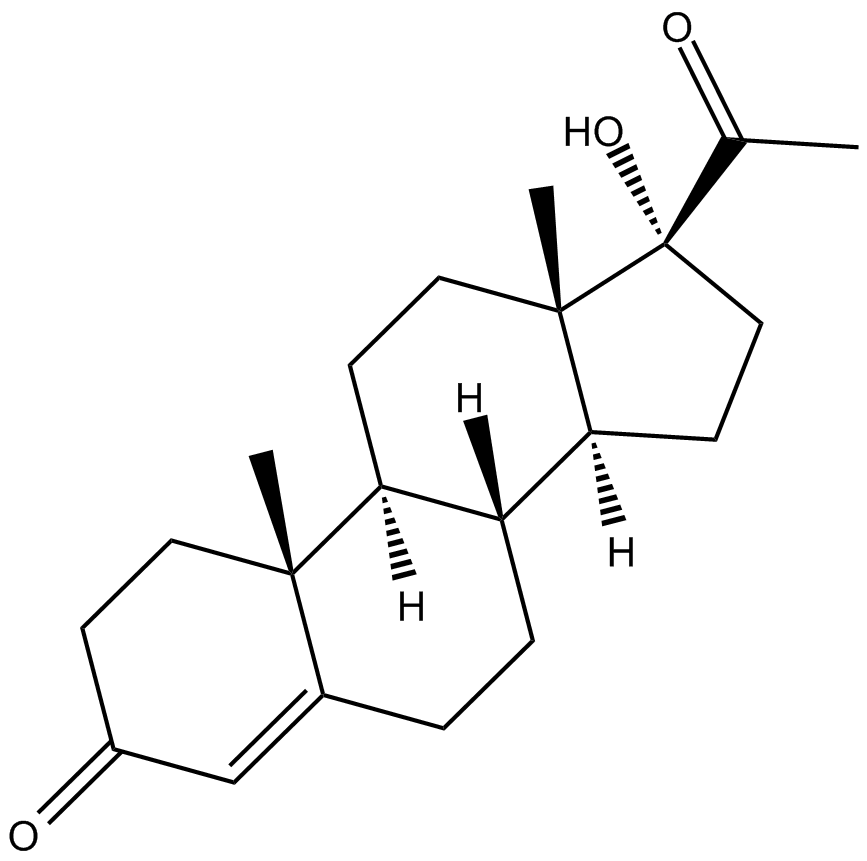17-Hydroxyprogesterone
17-Hydroxyprogesterone, an endogenous progestogen and chemical intermediate in the biosynthesis of other steroid hormones, is also the parent compound of various progestins derivatives.
In vitro: 17-Hydroxyprogesterone was found to be an agonist of the progesterone receptor (PR), which was similarly to progesterone. In addition, 17-hydroxyprogesterone was also an antagonist of the mineralocorticoid receptor (MR) as well as a partial agonist of the glucocorticoid receptor (GR), with very low potency (EC50>100-fold less relative to cortisol), which was also similarly to progesterone [1].
In vivo: Findings from a previous rat in vivo study demonstrated that even if modest, lowering blood pressure with 17-hydroxyprogesterone could be a viable treatment selection for blocking inflammation and uterine artery vasoconstriction, whereas improving litter size [2].
Clinical trial: Clinically, 17-hydroxyprogesterone has been evaluated in newborn screening programs as the biomarker to detect the rare but potentially fatal inherited disease, such as congenital adrenal hyperplasia. Results showed that the respiratory distress syndrome was related with higher 17-hydroxyprogesterone level. In addition, higher 17-hydroxyprogesterone and false positives were found to be significantly related with lower gestational age and birth weight, which was the same as that previously reported [3].
References:
[1] Barbara J. Attardi, et al. Comparison of progesterone and glucocorticoid receptor binding and stimulation of gene expression by progesterone, 17-alpha hydroxyprogesterone caproate (17-OHPC), and related progestins. Am J Obstet Gynecol. 2007 Dec; 197(6): 599.e1–599.e7.
[2] Lorena M. Amaral, et al. 17- hydroxyprogesterone caproate significantly improves clinical characteristics of preeclampsia in the Rupp rat model. Hypertension. 2015 Jan; 65(1): 225–231.
[3] Ryckman KK,Cook DE,Berberich SL,Shchelochkov OA,Berends SK,Busch T,Dagle JM,Murray JC. Replication of clinical associations with 17-hydroxyprogesterone in preterm newborns. J Pediatr Endocrinol Metab. 2012;25(3-4):301-5.
| Physical Appearance | A solid |
| Storage | Store at -20°C |
| M.Wt | 330.46 |
| Cas No. | 68-96-2 |
| Formula | C21H30O3 |
| Solubility | insoluble in H2O; ≥16 mg/mL in EtOH with gentle warming; ≥31.6 mg/mL in DMSO |
| Chemical Name | (8R,9S,10R,13S,14S,17R)-17-acetyl-17-hydroxy-10,13-dimethyl-6,7,8,9,10,11,12,13,14,15,16,17-dodecahydro-1H-cyclopenta[a]phenanthren-3(2H)-one |
| SDF | Download SDF |
| Canonical SMILES | C[C@](CC1)([C@@H](CC2)[C@H](CC3)[C@H]1[C@@](C)(CC1)C3=CC1=O)[C@]2(C(C)=O)O |
| Shipping Condition | Small Molecules with Blue Ice, Modified Nucleotides with Dry Ice. |
| General tips | We do not recommend long-term storage for the solution, please use it up soon. |
Quality Control & MSDS
- View current batch:
Chemical structure

Related Biological Data









